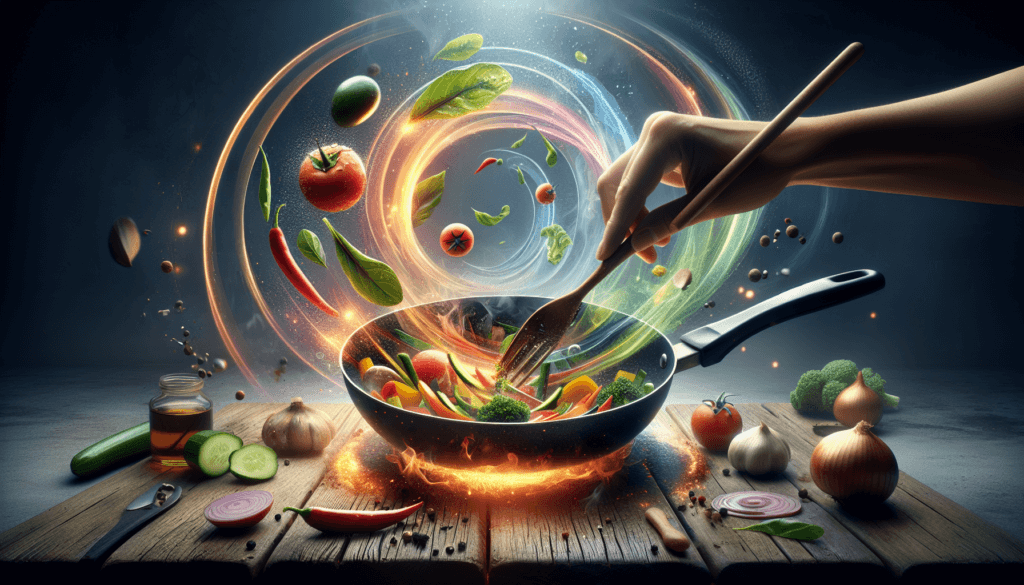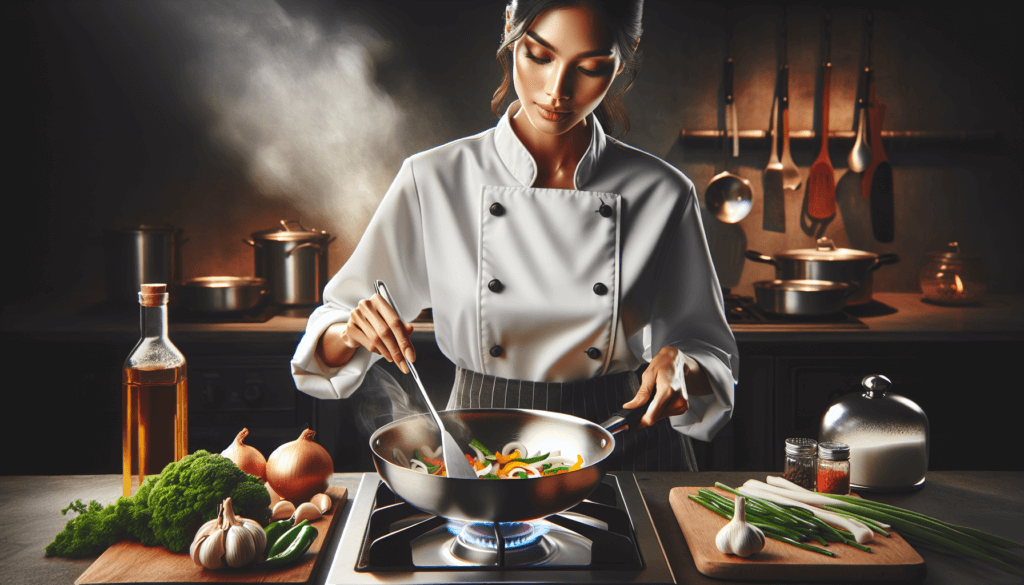Ready to take your cooking skills to the next level? Look no further than the art of sautéing. Whether you’re a novice in the kitchen or an experienced chef, mastering the technique of sautéing can elevate your dishes to new heights. From perfectly seared meats to beautifully caramelized vegetables, this versatile cooking method is a must-have in your culinary repertoire. In this article, we will explore the essential tips and tricks to help you become a sautéing maestro in no time. Get your aprons on and prepare to impress your taste buds!
How to Master the Art of Sautéing
Sautéing is a versatile cooking technique that can elevate any dish with its rich flavors and textures. Whether you’re a seasoned home cook or just starting out in the kitchen, mastering the art of sautéing is a skill that will serve you well. In this comprehensive guide, we will take you through every step of the sautéing process, from choosing the right pan to adding the perfect finishing touches. So, put on your apron and get ready to become a sautéing expert!

Consider the Material
When it comes to sautéing, choosing the right pan can make all the difference. Look for pans made from materials that distribute heat evenly, such as stainless steel or cast iron. Both of these materials can withstand high heat and allow for quick and efficient cooking. Additionally, non-stick pans can be a good option for sautéing delicate ingredients that may stick to other surfaces. Consider your cooking needs and preferences to determine which material is best for you.
Select the Right Size
The size of the pan is an important factor to consider when sautéing. A pan that is too small can overcrowd the ingredients, leading to uneven cooking and steaming rather than sautéing. On the other hand, a pan that is too large can make it difficult to control the heat and may result in overcooking or burning. As a general rule, choose a pan that provides enough space for your ingredients to spread out in a single layer, allowing them to cook evenly.
Look for a Well-Fitting Lid
A well-fitting lid is an often overlooked but essential accessory for sautéing. It helps to trap heat and steam, allowing your ingredients to cook more quickly and evenly. Additionally, a lid can be used to simmer or braise sautéed ingredients, resulting in tender and flavorful dishes. Look for a lid that fits snugly on your sauté pan and consider investing in a pan with a lid included for added convenience.
Wash and Dry Vegetables
Before you start sautéing, it’s important to wash and dry your vegetables thoroughly. Washing removes any dirt or debris that may be on the surface of the vegetables, while drying ensures that they will achieve a nice caramelized exterior when sautéed. Use a colander to rinse your vegetables under cold water, making sure to remove any excess moisture before adding them to the hot pan. This step will help to prevent steaming and ensure that your vegetables sauté to perfection.

Slice or Dice Ingredients Uniformly
To ensure even cooking, it’s important to slice or dice your ingredients into uniform pieces. This will help to create a consistent texture and prevent some pieces from overcooking while others remain undercooked. Aim for similar sizes and shapes when cutting your ingredients, and take the time to be precise. This attention to detail will make a noticeable difference in the final dish.
Mince Garlic and Onions
Garlic and onions are common aromatics used in sautéing, adding depth and flavor to your dishes. To maximize their flavor, it’s important to mince them finely. Mincing creates smaller pieces that will release their flavors more readily when cooked. Use a sharp knife and a cutting board with a stable surface to finely mince your garlic and onions. The extra effort will be well worth it when you taste the delicious results in your sautéed dishes.
Heat the Pan Properly
Properly heating the pan is crucial for successful sautéing. It allows for quick and consistent cooking, resulting in beautifully caramelized ingredients. Start by preheating your pan over medium-high heat for a few minutes. You can test if the pan is hot enough by adding a few drops of water – if they sizzle and evaporate immediately, the pan is ready. Be careful not to overheat the pan, as this can lead to burning and smoking.
Determine the Right Temperature
Once the pan is properly heated, it’s important to determine the right temperature for sautéing. For most sautéed dishes, a medium-high heat is sufficient. This allows for quick cooking without excessive browning or burning. However, for more delicate ingredients, such as seafood or leafy greens, a lower heat may be necessary to prevent overcooking. Pay attention to the recipe or adjust the heat as needed to achieve the desired results.

Practice Heat Control
Mastering heat control is a key skill in sautéing. It allows you to adjust the temperature as needed throughout the cooking process, preventing overcooking or burning. If the pan gets too hot and starts to smoke, reduce the heat immediately to avoid scorching the ingredients. On the other hand, if the pan is not hot enough and the ingredients are not sizzling, increase the heat slightly to maintain the proper cooking temperature. Paying attention to heat control will ensure that your sautéed dishes turn out perfectly every time.
Choose the Right Cooking Oil
Choosing the right cooking oil can enhance the flavors of your sautéed dishes. Common choices include olive oil, canola oil, and vegetable oil. Each has its own distinct flavor profile, so consider the overall taste you’re aiming for. Olive oil is known for its fruity and robust flavor, while canola oil is more neutral. Vegetable oil is a versatile option that can accommodate various flavors. Experiment with different oils to find your preferred choice for different dishes.
Consider Flavorful Fats
In addition to oils, flavorful fats can be used to add depth and richness to sautéed dishes. Butter and ghee are popular choices that impart a deliciously creamy and indulgent taste. Coconut oil can add a hint of tropical flavor, while rendered fats like bacon or duck fat can provide a savory and distinct essence. Consider the flavor profile of your dish and experiment with different fats to elevate the taste of your sautéed ingredients.
Use a Combination of Oils and Fats
Using a combination of oils and fats can enhance the flavors and textures of your sautéed dishes. For example, start by heating your pan with a high smoke point oil like canola or vegetable oil, which can withstand the heat without burning. As the sautéing process progresses, you can add a knob of butter or a spoonful of flavorful fat to enrich the taste and create a luscious mouthfeel. The combination of oils and fats will add complexity and depth to your sautéed dishes.

Saute Aromatics First
Aromatics, such as garlic and onions, play a crucial role in sautéing. They release their flavors and aromas when cooked, enhancing the overall taste of your dishes. It’s important to sauté the aromatics first before adding other ingredients, as their flavors develop with time. Start by adding minced garlic or finely chopped onions to the hot pan with a little oil. Sauté them until fragrant and translucent, taking care not to burn them. This foundation will infuse your sautéed dishes with mouthwatering aromas.
Optimize Flavor with Herbs and Spices
Herbs and spices are an excellent way to elevate the flavors of your sautéed dishes. Consider adding a sprinkle of dried herbs, such as thyme or rosemary, during the sautéing process to infuse the ingredients with their aromatic flavors. Fresh herbs, like basil or parsley, can be added towards the end of cooking for a burst of freshness. Additionally, spices such as cumin or paprika can add depth and complexity to your sautéed dishes. Experiment with different herbs and spices to discover your favorite flavor combinations.
Balance Salt and Pepper
Salt and pepper are universal seasonings that can enhance the taste of any sautéed dish. When sautéing, it’s important to season the ingredients at different stages of cooking to build layers of flavor. Start by seasoning the aromatics with a pinch of salt and pepper to bring out their flavors. As you add more ingredients, such as vegetables or proteins, continue to season lightly with salt and pepper to ensure each component is well seasoned. Taste and adjust the seasoning as needed throughout the cooking process, keeping in mind that flavors will concentrate as the dish reduces in volume.
Master the Toss and Flip
The toss and flip technique is essential for even cooking and browning in sautéing. It involves gently lifting and moving the ingredients in the pan, allowing them to cook and brown evenly. Use a spatula or tongs to lift and toss the ingredients, ensuring that they are consistently exposed to the hot surface of the pan. This technique also allows you to incorporate any flavorful bits, or fond, that may have formed on the bottom of the pan. With practice, you’ll become adept at the toss and flip, resulting in beautifully sautéed ingredients.

Avoid Overcrowding the Pan
One common mistake in sautéing is overcrowding the pan with too many ingredients. When the pan is overcrowded, the ingredients steam rather than brown, resulting in a lack of caramelization and texture. To avoid this, make sure that there is ample space in the pan for the ingredients to spread out in a single layer. Work in batches if necessary, sautéing smaller quantities at a time, to ensure that each piece has room to cook properly. This will allow your ingredients to develop the desired color and texture, resulting in flavorful and perfectly sautéed dishes.
Use the Fond
Fond is the browned bits that form at the bottom of the pan during sautéing. It is packed with concentrated flavors and can be used to enhance your sautéed dishes. To utilize the fond, deglaze the pan by adding a liquid, such as wine, broth, or even water. As the liquid evaporates, use a spatula to scrape the bottom of the pan, loosening and incorporating the fond into the sauce. This process adds complexity and depth to your sautéed dishes, creating a deliciously rich and flavorful sauce.
Cook Vegetables Until Crisp-Tender
When sautéing vegetables, it’s important to cook them until they are crisp-tender. This means that they should still have a slight bite to them, while also being cooked through. Overcooking vegetables can result in a mushy texture and loss of flavor. To achieve the desired crisp-tender texture, monitor the cooking time and test the doneness of the vegetables by tasting a piece. Once they are cooked to your preference, remove them from the heat to prevent them from becoming overcooked.
Achieve the Desired Texture for Meats
Sautéed meats can range from tender and juicy to crispy and caramelized, depending on your desired outcome. To achieve a tender and juicy texture, sauté the meats quickly over high heat, just until they are cooked through. For a crispy and caramelized texture, cook the meats for a longer time, allowing them to brown and develop a flavorful crust. Adjust the cooking time and heat level based on the desired texture and the specific cut of meat you are sautéing.
Caramelize Onions and Mushrooms
Caramelizing onions and mushrooms can add a rich and sweet flavor to your sautéed dishes. To achieve this, start by sautéing them over medium heat with a little oil or butter until they become soft and translucent. Then, reduce the heat to low and continue cooking, stirring occasionally, until the onions and mushrooms turn a deep golden brown. This slow cooking process allows the natural sugars in the onions and mushrooms to caramelize, resulting in a deliciously sweet and savory flavor.
Utilize the Fond for Flavor
When deglazing the pan to create sauces, utilize the fond for maximum flavor. As you add a liquid to the hot pan, the fond will dissolve and release its concentrated flavors, infusing the sauce with rich taste. Use a spatula to scrape the bottom of the pan, ensuring that you collect all of the flavorful fond. This technique enhances the depth and complexity of your sauces, transforming them into a culinary delight.
Add Liquid to Deglaze the Pan
Deglazing the pan with liquid is a technique used to create flavorful sauces and gravies from the fond. After sautéing your ingredients, remove them from the pan and set them aside. Then, add a liquid such as wine, broth, or even water to the hot pan. The liquid will dissolve the fond on the bottom of the pan, incorporating its flavors into the sauce. Allow the liquid to reduce and thicken slightly before adding back the sautéed ingredients. This simple step can elevate your sautéed dish to a whole new level.
Thicken Sauces if Desired
If you prefer a thicker sauce or gravy, you can thicken it using various techniques. One common way is to create a slurry by mixing a starch, such as cornstarch or flour, with a small amount of liquid until smooth. Then, slowly add the slurry to the simmering sauce, stirring constantly, until it reaches the desired consistency. Another method is to use a reduction technique, where you simmer the sauce over low heat, allowing the liquid to evaporate and the sauce to thicken naturally. Experiment with different thickening methods to achieve the perfect sauce for your sautéed dishes.
Consider Complementary Side Dishes
When planning your sautéed dish, consider the accompaniments or side dishes that will complement the flavors and textures. For example, sautéed vegetables can be served alongside a grain pilaf or a creamy mashed potato. Sautéed seafood pairs beautifully with citrusy salads or roasted vegetables. Sautéed meats can be served with a rich sauce, accompanied by roasted root vegetables or a crisp salad. Think about the overall balance of flavors and textures when selecting your side dishes to create a delicious and harmonious meal.
Pair Sauteed Seafood with Citrus
Sautéed seafood has a delicate and briny flavor that pairs wonderfully with citrus. The acidity of citrus fruits cuts through the richness of the seafood, providing a refreshing and bright contrast. Squeeze a fresh lemon or lime over your sautéed seafood just before serving, or create a citrus-based sauce to drizzle on top. The citrus infusion will elevate the flavors of the seafood, creating a well-balanced and tantalizing dish.
Pair Sauteed Meats with Rich Sauces
Sautéed meats can benefit from the addition of rich sauces that complement their flavors. Creamy sauces, such as a velvety mushroom sauce or a decadent red wine reduction, can add depth and richness to sautéed meats. The velvety texture and savory flavors of the sauces create a luxurious dining experience. Experiment with different sauces to find the perfect pairing for your sautéed meats and create a dish that will impress even the most discerning palate.
Add Fresh Herbs or Citrus Zest
To add a burst of freshness and brightness to your sautéed dishes, consider adding fresh herbs or citrus zest as a finishing touch. Finely chop fresh herbs like parsley, basil, or cilantro and sprinkle them over the sautéed ingredients just before serving. The vibrant flavors and fragrances of the herbs will awaken your taste buds and enhance the overall dish. Alternatively, grate the zest of citrus fruits, such as lemon or orange, over the sautéed ingredients to infuse them with a zesty and aromatic flavor. These small additions can take your sautéed dishes from ordinary to extraordinary.
Finish with a Drizzle of High-Quality Oil
A drizzle of high-quality oil can add a luxurious finishing touch to your sautéed dishes. Olive oil, infused oils, or specialty oils like truffle oil can impart a unique flavor and silky texture to the dish. After sautéing your ingredients, remove them from the heat and drizzle a small amount of your chosen oil over the top. The oil will enhance the flavors and provide a luscious mouthfeel, elevating your sautéed dish to a gourmet experience.
Garnish with Texture and Contrast
To provide a visual and textural contrast to your sautéed dishes, consider garnishing them with ingredients that add crunch or a pop of color. Toasted nuts, such as almonds or pine nuts, add a delightful crunch and nuttiness to sautéed dishes. Freshly chopped herbs or microgreens can add vibrant colors and a delicate texture. Sprinkle these garnishes over the sautéed dish just before serving to create an enticing presentation and a delightful eating experience.
By following these comprehensive guidelines, you will be well on your way to master the art of sautéing. Remember to choose the right pan, prep your ingredients correctly, control the heat, and use the proper oils and fats. Experiment with different aromatics, seasonings, and sautéing techniques to create a wide range of delicious dishes. And don’t forget to add the perfect finishing touches to elevate your sautéed creations. With time and practice, you will become a sautéing expert, impressing yourself and others with your culinary skills. So, put these tips into action and enjoy the flavorful and beautifully sautéed dishes that you create!


